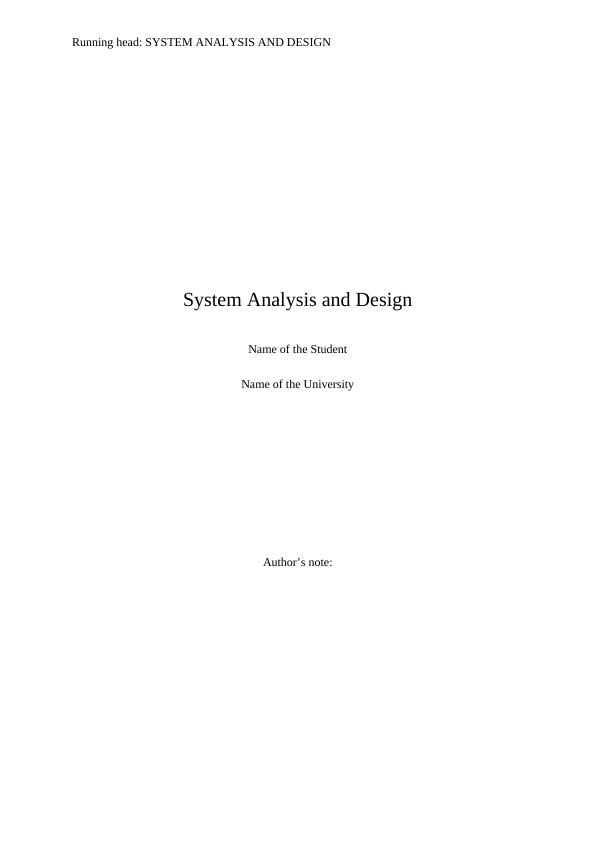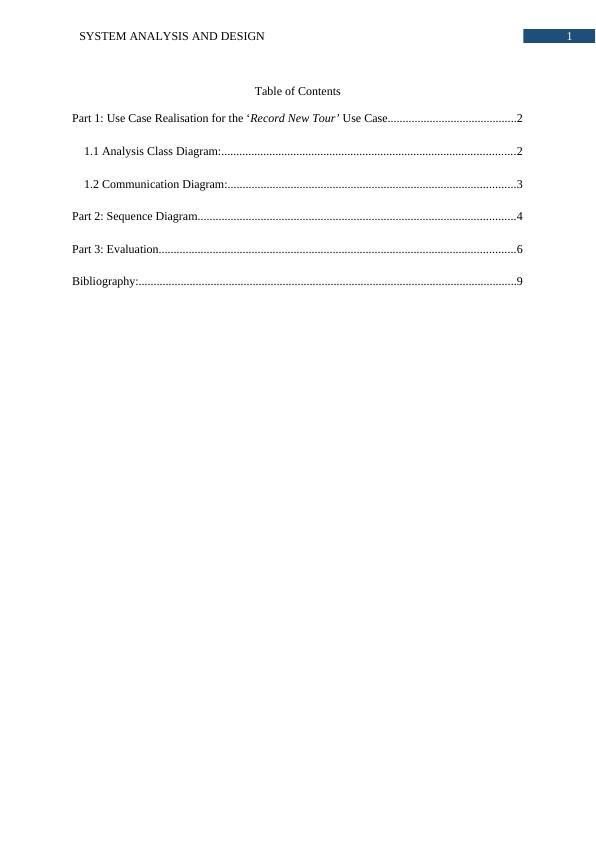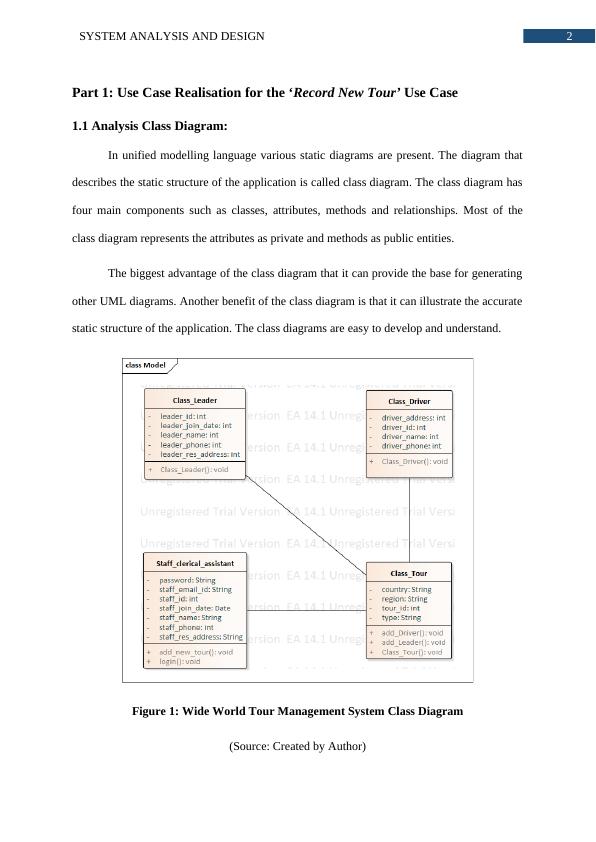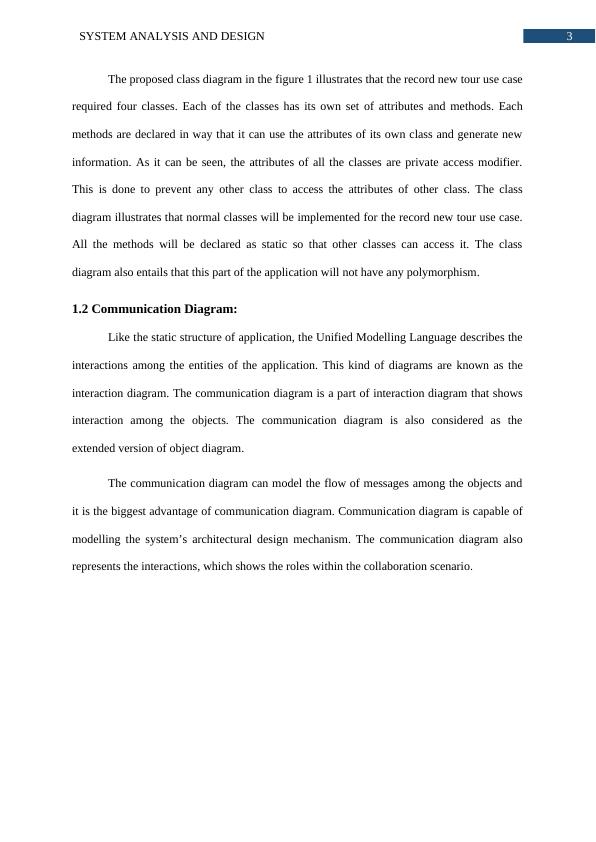System Analysis and Design
Added on 2023-04-20
11 Pages2198 Words489 Views
Running head: SYSTEM ANALYSIS AND DESIGN
System Analysis and Design
Name of the Student
Name of the University
Author’s note:
System Analysis and Design
Name of the Student
Name of the University
Author’s note:

1SYSTEM ANALYSIS AND DESIGN
Table of Contents
Part 1: Use Case Realisation for the ‘Record New Tour’ Use Case...........................................2
1.1 Analysis Class Diagram:..................................................................................................2
1.2 Communication Diagram:................................................................................................3
Part 2: Sequence Diagram..........................................................................................................4
Part 3: Evaluation.......................................................................................................................6
Bibliography:..............................................................................................................................9
Table of Contents
Part 1: Use Case Realisation for the ‘Record New Tour’ Use Case...........................................2
1.1 Analysis Class Diagram:..................................................................................................2
1.2 Communication Diagram:................................................................................................3
Part 2: Sequence Diagram..........................................................................................................4
Part 3: Evaluation.......................................................................................................................6
Bibliography:..............................................................................................................................9

2SYSTEM ANALYSIS AND DESIGN
Part 1: Use Case Realisation for the ‘Record New Tour’ Use Case
1.1 Analysis Class Diagram:
In unified modelling language various static diagrams are present. The diagram that
describes the static structure of the application is called class diagram. The class diagram has
four main components such as classes, attributes, methods and relationships. Most of the
class diagram represents the attributes as private and methods as public entities.
The biggest advantage of the class diagram that it can provide the base for generating
other UML diagrams. Another benefit of the class diagram is that it can illustrate the accurate
static structure of the application. The class diagrams are easy to develop and understand.
Figure 1: Wide World Tour Management System Class Diagram
(Source: Created by Author)
Part 1: Use Case Realisation for the ‘Record New Tour’ Use Case
1.1 Analysis Class Diagram:
In unified modelling language various static diagrams are present. The diagram that
describes the static structure of the application is called class diagram. The class diagram has
four main components such as classes, attributes, methods and relationships. Most of the
class diagram represents the attributes as private and methods as public entities.
The biggest advantage of the class diagram that it can provide the base for generating
other UML diagrams. Another benefit of the class diagram is that it can illustrate the accurate
static structure of the application. The class diagrams are easy to develop and understand.
Figure 1: Wide World Tour Management System Class Diagram
(Source: Created by Author)

3SYSTEM ANALYSIS AND DESIGN
The proposed class diagram in the figure 1 illustrates that the record new tour use case
required four classes. Each of the classes has its own set of attributes and methods. Each
methods are declared in way that it can use the attributes of its own class and generate new
information. As it can be seen, the attributes of all the classes are private access modifier.
This is done to prevent any other class to access the attributes of other class. The class
diagram illustrates that normal classes will be implemented for the record new tour use case.
All the methods will be declared as static so that other classes can access it. The class
diagram also entails that this part of the application will not have any polymorphism.
1.2 Communication Diagram:
Like the static structure of application, the Unified Modelling Language describes the
interactions among the entities of the application. This kind of diagrams are known as the
interaction diagram. The communication diagram is a part of interaction diagram that shows
interaction among the objects. The communication diagram is also considered as the
extended version of object diagram.
The communication diagram can model the flow of messages among the objects and
it is the biggest advantage of communication diagram. Communication diagram is capable of
modelling the system’s architectural design mechanism. The communication diagram also
represents the interactions, which shows the roles within the collaboration scenario.
The proposed class diagram in the figure 1 illustrates that the record new tour use case
required four classes. Each of the classes has its own set of attributes and methods. Each
methods are declared in way that it can use the attributes of its own class and generate new
information. As it can be seen, the attributes of all the classes are private access modifier.
This is done to prevent any other class to access the attributes of other class. The class
diagram illustrates that normal classes will be implemented for the record new tour use case.
All the methods will be declared as static so that other classes can access it. The class
diagram also entails that this part of the application will not have any polymorphism.
1.2 Communication Diagram:
Like the static structure of application, the Unified Modelling Language describes the
interactions among the entities of the application. This kind of diagrams are known as the
interaction diagram. The communication diagram is a part of interaction diagram that shows
interaction among the objects. The communication diagram is also considered as the
extended version of object diagram.
The communication diagram can model the flow of messages among the objects and
it is the biggest advantage of communication diagram. Communication diagram is capable of
modelling the system’s architectural design mechanism. The communication diagram also
represents the interactions, which shows the roles within the collaboration scenario.

End of preview
Want to access all the pages? Upload your documents or become a member.
Related Documents
System Analysis and Designlg...
|12
|2423
|352
System Analysis and Designlg...
|11
|2205
|266
System Analysis and Designlg...
|11
|2293
|223
System Analysis and Designlg...
|12
|2131
|342
System Analysis and Design for Wide World Tour Management Systemlg...
|12
|2236
|53
System Analysis and Designlg...
|10
|1954
|331
